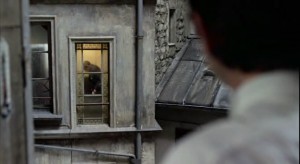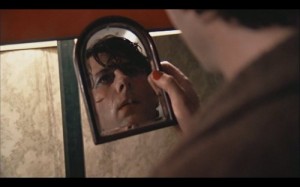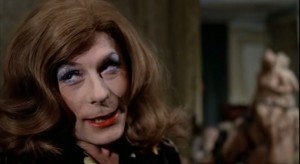From Sight and Sound (Autumn 1976). — J.R.
Behind the credits, a face peering out through a window; a downward pan revealing a vertiginous drop to the courtyard below; a pan back to the window and round the court to another face, a girl’s, which quickly turns into Roman Polanski’s; a continuing movement past a chimney, across more windows-down one side of the building, over a railing and up another side — eventually coming round to the door leading to the street, which Polanski enters . . . If the remainder of The Tenant were as impressive as the first shot, we conceivably might have had a masterpiece on our hands. Nearly as concise as the extended crane shot opening Touch of Evil, it differs from the latter by arranging its arsenal of elements into a non-narrative pattern — a set of materials which, except for the girl turning into Polanski, are related spatially but nor chronologically, until Polanski’s entrance through the street door launches the story proper.
A naturalised Pole named Trelkovsky is interested in seeing a flat, and the unfriendly concierge (Shelley Winters) gives him a hard time about it, agreeing to take him upstairs only after he slips her some money. Showing him the rather stale two rooms and remarking that the toilet is down the hallway, she also notes, ‘The previous tenant threw herself out of the window’ and falls into jolly laughter, adding ‘She’s not dead yet’ but instantly reassuring him that she won’t recover. Before long, he is negotiating with the morose Mr. Zy (Melvyn Douglas), who warns him that it’s a quiet building and he won’t tolerate the tenant entertaining young ladies in his room.
A bitterly precise portrayal of the sort of ungenerous xenophobia a non-French tenant is likely to encounter in Paris, such attitudes are only forecasts of what Trelkovsky has to face once he moves in. Although the film’s French version confronts us with a dubbed Winters and Douglas –in contrast with a dubbed Isabelle Adjani in this [U.K.] version — it also makes the anti-French strain a lot more explicit. Beneath this is an expression of humane anguish, poignantly underlined by Polanski’s subtle performance, about the conditions imposed by city living, where the mere existence of a neighbour can be an imposition and a suicide can wind up functioning as a means of providing someone else with living space. The implication, duly borne out by the film itself, is that such a situation could drive anyone mad. But beneath this notion in turn are the formal operations through which Polanski develops it — providing an insight into both the strengths and limitations of his work.
Ever since Knife in the Water, his career has largely gravitated round the problem of reconciling certain formal interests with the more ‘saleable’ sides of his artistic persona (principally black humour and a taste for Grand Guignol). It is significant that What?, the film where his formal concerns are probably most evident, might well be the least critically and commercially successful of his efforts to date; if satire, according to George S. Kaufman, is what closes in New Haven, formalism in mainstream cinema can’t even hope for an East Orange preview unless it sneaks in under another label, usually stylistic or thematic. In the case of Polanski, this taboo seems to have brought about a kind of schizophrenia no less troubling than some of his disordered characters — a sense of cross-purposes that finally splits The Tenant into virtually dissociated sections.
Film No. 1, roughly the first half, exhibits Polanski’s formalist side, above all in its accumulation of partis pris and its ambiguous treatment of ‘objective’ facts and subjective states of mind. As in What?, many of these factors can be located in the soundtrack. The water dripping from Trelkovsky’s kitchen tap, the rattle of pipes, the squeak of his cupboard door, the repetitive piano exercises heard from the stairway, the faint cooing of pigeons in the courtyard and the angry pounding of the neighbour upstairs all outline the space of a constricted consciousness; while the latter — always provoked by the sounds made in Trelkovsky’s flat — draws particular attention to this register of awareness. And when Trelkovsky turns from cooking to answer an apparent knock at the door — only to find no one there — one may well wonder whether or not one did hear a knock: the sensitivity to sound developed in the spectator combines with ambiguity to become an acute form of aggression. The bizarre bloodcurdling scream of Simone, the former tenant — bandaged from head to toe when Trelkovsky visits her in the hospital, where he meets her friend Stella (Isabelle Adjani) — is significantly accompanied by a zoom to her mouth. And on the verbal level of sound, who is to say when or how (or even if) the priest’s sermon at Simone’s funeral becomes the hero’s own projection when the subject turns to the putrefaction of corpses? Comparable uncertainties are created in visual terms: is the blonde girl Trelkovsky glimpses at the funeral the crippled daughter of his persecuted neighbour Mme. Gaderian (Lila Kedrova), whom we see Iater? Is her later appearance also an illusion — which is suggested when Mme. Dioz (Jo Van Fleet), her mother’s persecutor, flatly states that Mme. Gaderian has a son, not a daughter ? At what stage do the strange appearances of figures standing in the toilet across from Trelkovsky’s window stop being mysteries and start becoming hallucinations?
If Film No. 1 is largely devoted to posing such questions in the form of brilliant notations, Film No. 2 — by establishing that the hero has gone mad — laboriously proceeds to answer others. A cut from Trelkovsky grasping his own throat to Mme. Dioz attempting to strangle him clearly labels the second shot as a hallucination; and countless other juxtapositions between real and imagined torments lead one straight into the clinical context of Repulsion. To put it as crudely as the film does, this is the kind of violence that audiences pay to see, with ‘reality’ and ‘imagination’ slotted into separate compartments so that one can watch the hero’s agony from a safe voyeuristic distance. There is, to be sure, a moralistic point implied in much of this: the ‘unexplained’ ransacking of Trelkovsky’s flat is later echoed by his own ransacking of Stella’s flat in a paranoiac rage, suggesting that victims eventually take on the behaviour of their persecutors. And when, for instance, Trelkovsky flees to a hotel and gazes out of a window, where he and we see two workmen who might be looking up at him, the earlier terms of the film are briefly allowed to reverberate. But by this time it is too late: after Trelkovsky has gradually gone through the process of becoming Simone — even dressing up as a woman, and eventually jumping twice in succession from the same window — the see-sawing movement between ‘truth’ and ‘illusion’ has become too mechanical for either to carry much conviction. And when Polanski ends with a paraphrase of the previous hospital scene — Trelkovsky (apparently) encased like a mummy in bandages, looking up at Trelkovsky and Stella, then screaming while the camera zooms towards his mouth -– formal interest has shrunk to the level of stylistic pirouette, and ambiguity becomes just the other side of apathy.
JONATHAN ROSENBAUM







